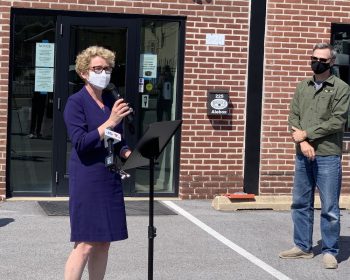By Mike McGann, Editor, The Times @mikemcgannpa

U.S. Rep. Chrissy Houlahan speaks at a media event Monday to highlight the threat to the local economy from the Spotted Lanterfly, as Braeloch Brewing owner Ken Steeves looks on.
KENNETT SQUARE — If you are a beer or wine lover — or a fan of Chester County’s great agricultural products — you have a new Public Enemy, No. 1: the Spotted Lanternfly.
This was the message that U.S. Rep. Chrissy Houlahan (D-6) brought to a media conference at Braeloch Brewing, Monday, focusing on the need for intervention to stop the spread of the Spotted Lanternfly (SLF) which loves to feed on winery grapes and hops — a key ingredient in beer — not to mention various other agricultural products grown in the region. She was welcomed by Braeloch’s owner, Kent Steeves and Kennett Square’s Mayor, Matt Fetick.
Like the widely despised stinkbug, the SLF is native to southeast Asia, where it has natural predators to keep the population in control. Since being discovered in southeast Pennsylvania in 2014, where it has no known natural predators, it has grown in numbers, attacking vegetation.
Houlahan highlighted her efforts last year on a successful bipartisan bill that offered some $16 million in funding to help fight this newest threat to the region’s agriculture and wine grape growers, both of which are key drivers of the county’s overall farming economy. She is working on a new bill, one she says again has bipartisan support and support among Pennsylvania’s Congressional delegation. Referring to the SLF as an “invasive, plant hopper” Houlahan detailed why this insect is such a threat to the region and Chester County.
“It’s been very destructive and detrimental to our area,” she said.
She noted that the insect could cause major economic impact in the county — some $66 million Houlahan said — but the hit statewide will be an order of impact worse.
“Economic data from Penn State University shows that the Spotted Lanternfly could cost Pennsylvania up to $324 million annually to our state economy and could cause the loss of 2,800 jobs.,” she said. “So this is serious stuff from a very pretty but very toxic little creature.”
By last summer, the invasive species became widely seen around Chester County and it seems likely that the spread will continue and grow this year, experts say. With local businesses already struggling the face of the pandemic, Houlahan said it is imperative for government to take additional action to reduce this threat to the local economy.
“So after the year of 2020 and the economic devastation the pandemic has caused, we need to do everything in our power as leaders to make it as easy as possible for our small businesses to grow — that includes thinking about the Spotted Lanternfly,” she said.
Houlahan said she is pushing for a larger investment this year in stopping the Spotted Lanternfly.
Fettick thanked Houlahan for stepping up on this issue, noting the importance of agriculture in Chester County.
“Agriculture continues to be a driving economic force of our community,” Fettick said. “Not only for those who are farmers, in the greater Kennett Square Area, but also the restaurants, the breweries and the vineyards that count on local produce — both on their menus, but also vineyards and breweries (which depend on local products in production).”
Heather Leach, an entomologist from Penn State University, spoke in some detail about the threat of the insect, how it has spread and efforts to contain and reduce its impact in the region and in the commonwealth.
One problem: as of now, there is no obvious predator to keep down the Spotted Lanternfly population, but she expressed hope that as we’ve seen with the stinkbug, indigenous species would begin to develop a taste for the insects, helping to control their population.
“This is a a point of new research focus,” Leach said. “And what we’re finding is that there are what we call ‘generalist predators’ — things like praying mantis’, spiders, and even some birds, including owls and all sorts of other birds are starting to eat Spotted Lanternflys. They’re starting to learn that this is a new food source.”
Although the spread continues in our immediate area, Leach said that local residents can help to stop the spread to other regions of the county by inspecting their vehicles before trips out of the region — the SLF is apparently quite good at hanging on the vehicles even at highway speeds, she said.
For more information on locating, managing and reporting SLF and egg clusters, Penn State offers a complete FAQ: https://extension.psu.edu/spotted-lanternfly-frequently-asked-questions






